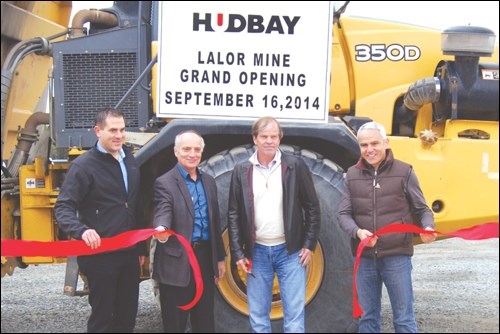A decade ago, following the old adage that the best place to find a new mine is in the shadow of an existing one, a team of prospectors found themselves at work near the town of Snow Lake.
Truth be told, they were closer to Lalor Lake, a body of water named after Fintan Howard Lalor, a Canadian pilot officer and navigator presumed deceased after his plane went missing in eastern Canada in 1943.
In any event, the prospectors’ goal was the same as it always was: coordinate their drilling so as to pinpoint northern Manitoba’s next mine.
The crew was in the employ of HudBay Minerals, formerly HBM&S and now known simply as Hudbay. Racking up sky-high profits at the time, the company was eager to build on its prolific mining legacy in the Flin Flon-Snow Lake region.
So why target Lalor Lake? The obvious answer was its close proximity to Snow Lake, which could supply workers to a mine, and even closer proximity to Hudbay’s lucrative Chisel North mine, indicative of the mineral-rich potential of the area.
But there was more to the story. Fifteen years earlier, in 1992, came the first sign of a potentially mine-worthy deposit at Lalor Lake: a deep drill hole known as DUB-33.
Jerry Kitzler, the long-time senior exploration geologist for Hudbay in Snow Lake, spoke about DUB-33 in an interview for the book Headframes, Happiness, and Heartaches by James R.B. Parres and Marc Jackson.
Kitzler noted drilling hit five centimetres of sulphide in DUB-33. Geologists performed a borehole pulse survey on the hole and found “there was something there that we missed, an anomaly that was huge.”
Unfortunately Anglo American, which owned HBM&S at the time, did not provide funding for deep drill holes to further investigate this potential.
Finding mines
By 2007, however, Hudbay was under new ownership and flush with cash thanks to soaring metal prices. The company was serious about finding new mines, allotting $37 million for exploration that year.
Much has been written about the discovery of the Lalor deposit – the “Lake” was eventually dropped – and the geologists and executives who played a role therein.
In a 2011 interview with Cottage North magazine, Dave Koop, president of Flin Flon-based Koop Geotechnical, spoke of his involvement with the project. His company had a history of working for Hudbay and was hired to conduct surveys at Lalor.
Koop recalled the day in March 2007 when crews hit the mother lode at the site. Word came in the form of a phone call from Alan Vowles, then the principal geophysicist for Hudbay’s exploration department.
“He asked if I was sitting down,” Koop recalled with a chuckle. “I said sure.”
Vowles relayed how drilling had hit the “big time.” When the men observed the now-legendary drill core, “Alan and I just turned, shook each other’s hand and said congrats. We knew it was just the beginning,” Koop said.
The Lalor crew had intersected zinc – an immense amount of zinc that generated interest at the highest levels of Hudbay.
Peter Jones, then president and CEO of the company, called the intersection “very encouraging,” adding, “I look forward to the next group of holes to confirm the results of the first intersection and hopefully define a substantial and new high-grade deposit.”
While Jones was tempered in his remarks, a fierce belief that Lalor would be Hudbay’s next mine took root across Flin Flon-Snow Lake. After 80 years of mining in the region, it was as though residents could intuitively distinguish Lalor from all of the other wannabe mines.
Key to the Lalor discovery had been a type of prospecting known as remote sensing. In a 2012 article, the Globe and Mail’s Paul Brent noted this technique lets prospectors “find deposits at increasing depths without physically drilling into the earth but rather by measuring underground electromagnetic properties either from the ground or from the air.”
Hudbay had “used a combination of high-powered transmit loops and extremely long remote sensing periods to peer deep into the earth” to first identify the deposit, Brent wrote.
As Vowles told Brent, “We were able to image the ore body where we wouldn’t have been able to with previous technologies.”
Optimism swells
After the discovery hole of March 2007, optimism around Lalor continued to swell. Not only was the deposit rich in zinc, geologists learned, but it also contained a vast volume of gold – enough to support a mine on its own – along with copper and silver.
Indeed Lalor had become one of the most significant discoveries ever made in the Flin Flon-Greenstone Belt – and considering the region’s fabled mining history, that was saying something.
On the morning of October 8, 2009, Hudbay executives countered a gloomy recession-era mining atmosphere in spectacular fashion by approving $85 million to begin development of the Lalor mine.
The funds would pay for the first phase of the project, a three-kilometre underground production ramp linking the existing Chisel North mine with the Lalor deposit.
“Moving forward with Lalor is a key strategic milestone for Hudbay,” Jones, still Hudbay’s president and CEO, said at the time.
Jones set an ambitious timeline for the new mine: initial production by 2012 and full production in 2014. Martin Cash of the Winnipeg Free Press would later call Lalor “one of the fastest discovery-to-development [mining] projects in the country.”
Then-Snow Lake mayor Garry Zamzow was over the moon.
“I don’t know how much of the province realizes how huge the Lalor project will be,” Zamzow told the Free Press at the time. “There have been drills running there for all these months. There has to be something down there.”
In early October 2010, almost one year after Hudbay announced the new mine, officials gathered at the Lalor site for the ceremonial first blast.
By then David Garofalo had replaced Jones as company president and CEO. He shared his predecessor’s passion for the Lalor project – and then some.
“We don’t really know how big this deposit is going to be, how big our production scale is going to be, [or] how big the [processing] plant is going to be,” Garofalo said at the ceremony. “This deposit is going to grow – that’s the only thing I know for sure.”
Bumpy path
Lalor followed a sometimes-bumpy path to production. In a span of 37 days in early 2013, Indigenous protestors twice formed blockades outside the property.
The protestors, led by Chief Arlen Dumas of Pukatawagan-based Mathias Colomb Cree Nation, argued Hudbay did not have permission to operate on their traditional territory.
The courts disagreed. In March 2013, Hudbay was granted an injunction against any further blockades. Mounties were instructed to enforce the court order.
As promised, Lalor reached initial production in 2012, with ore removed through the ventilation shaft while the main production shaft was being completed.
On September 16, 2014, with its $441-million construction budget expended, the full-strength Lalor mine officially opened. Hudbay’s smaller Reed mine, located between Flin Flon and Snow Lake, opened the same day.
“Northern Manitoba is the foundation of Hudbay’s success. The milestone of officially opening Lalor and Reed is the newest chapter in our long history here,” Garofalo said that day.
As part of the Lalor project, Hudbay upgraded its Stall concentrator near Snow Lake to accommodate additional ore. Today, a further increase to processing capacity is planned.
In 2015, Hudbay bought the idle gold mill formerly used at New Britannia gold mine in Snow Lake. The company is now refurbishing the mill to take in Lalor’s gold.
Still early into its impressive run, Lalor carries a bright outlook.
“This is the biggest deposit in the Snow Lake area and probably the second or third biggest in the Flin Flon camp itself,” Cashel Meagher, senior vice-president and chief operating officer of Hudbay, told the Canadian Mining Journal last month.
Meagher said the company was re-evaluating exploration opportunities and wanted to “perpetuate” the life of Lalor, which based on current reserves is projected to last until 2027.
On the economic front, Lalor has been a massive boon not only to Snow Lake, but also to Flin Flon, from which the mine derives many of its employees.
As of March 2017, Lalor and the Stall concentrator employed 310 people, excluding contractors. Hudbay recently noted it may need as many as 100 additional employees at the mine in the coming years.
Ten years after its discovery, Lalor is still proving the old adage that the best place to find a new mine is in the shadow of an existing one.
– With files from The Reminder and Cottage North archives




